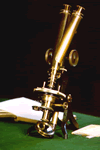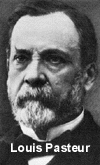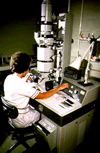For most of human history, people thought that illness was caused by evil spirits.
Hippocrates (400BC Greece) realised that the environment can affect health, and he scientifically observed symptoms and tried to diagnose underlying causes.
Herbal remedies have long produced relief from suffering, but our understanding and knowledge of structure and function in organisms has only recently developed following the advancement of new techniques and instruments.
The following is a brief summary of the development of new techniques which have expanded our knowledge of modern medicine.
1628 Harvey (England) discovered that the heart pumps blood around the body in one direction.
 1673 Anton van Leeuwenhoek (Holland) improved simple microscopes
and observed micro-organisms.
1673 Anton van Leeuwenhoek (Holland) improved simple microscopes
and observed micro-organisms.
1798 Jenner (UK) developed the idea of vaccination using cowpox "germs" to immunise against deadly smallpox.
1816 Laennec (France) invented a simple stethoscope for studying the heart.
1839 Schwann (Germany) discovered that animals as well as plants are made of cells.
1842 Chadwick (UK) related inadequate sanitation and hygiene to disease.
1846 Morton (USA) first used laughing gas (nitrous oxide) and ether as general anaesthetics, allowing more extensive surgical operations.
 1857 Pasteur (France) proved that micro-organisms caused disease
and fermentation of wine, and that micro-organisms were not spontaneously
generated but carried in the air.
1857 Pasteur (France) proved that micro-organisms caused disease
and fermentation of wine, and that micro-organisms were not spontaneously
generated but carried in the air.
1865 Lister (UK) used carbolic acid as the first antiseptic to kill "putrid particles".
1867 Allbutt (UK) developed the first convenient mercury thermometer.
1889 Halsted (USA) realised the need for hygiene in surgery and invented rubber gloves.
1895 Roentgen (Germany) discovered X-Rays. The more dense tissue (bone, tumours or areas pre-darkened by opaque dyes, for example, bowel) show up white on the photographic film.
 1897
Ehrlich (Germany) discovered that the body made antibodies to toxins.
1897
Ehrlich (Germany) discovered that the body made antibodies to toxins.
1902 Landsteiner (Austria) discovered the four blood groups (A, B, AB, O) allowing safer blood transfusions.
1903 Einthoven (Holland) made an Electrocardiograph (ECG) sensitive enough to measure electrical impulses of the heart.
1921 Benting and Best (Canada) extracted insulin from a dog's pancreas and showed its importance in treating diabetes.
1924 Berger (Germany) invented an electroencephalogram (EEG) to measure electrical activity in the brain.
1928 Ruska (Germany) built the first electron microscope using an electron beam instead of light to give 3D high magnification of structures inside cells.

|

|
1928 Fleming (UK) isolated penicillin, the first antibiotic.
1935 Domagk (Germany) first treated bacterial infections with sulphanilamide drugs.
1940 Florey (UK) used antibiotics to treat human disease.
1952 Briggs and King cloned the first animals using tadpole eggs.
1953 Crick, Watson and Franklin (UK) unravelled the double helix structure of DNA commencing new research on gene action.
1955 Marker and Pincus (US) developed the oral contraceptive pill.
1957 Donald (UK) invented the use of ultrasound techniques for study of foetal development.
1960 Macfarlane Burnet (Aust.) isolated the flu virus and refined our knowledge of immunisation.
1962 Hounsfield (UK) developed Computer-Aided Tomography (CAT Scanning), linking X-rays with a computer to give 3D brain pictures.
1964 Ingram (USA) developed laser surgery.
1965 Hopkins (UK) developed the endoscope allowing photography of internal ducts.
1967 Barnard (S. Africa) performed the first heart transplant.
1978 Steptoe (UK) refined in-vitro fertilisation and Louise Brown, the first externally-fertilised baby was born.
1985 Brinster created the first transgenic livestock; pigs that produce human growth hormone.
1997 Campbell (UK) produced Dolly, a sheep cloned from an adult cell.
2000 USA and UK both announce the completion of the mapping of the human genome (gene order).
Present day technology
Today, screening is common, to detect disease before it produces symptoms,
to allow early treatment e.g. smear testing for cervical cancer.
- Blood testing is widely used to identify disease organisms and hence
the appropriate use of specific drugs to treat diseases.
- DNA Testing allows identification of particular individuals by their
unique genetic code and allows genetic counselling for those carrying
genes likely to cause problems in their children, or early treatment
for a child born with a genetic disorder.
- Nuclear Magnetic Resonance (NMR) can give 3D images down to the atomic
level.
- Intensive Care Units house continual monitoring devices to show immediate responses to treatment.
| Copyright owned by the State of Victoria (Department of Education and Early Childhood Development). Used with Permission. |